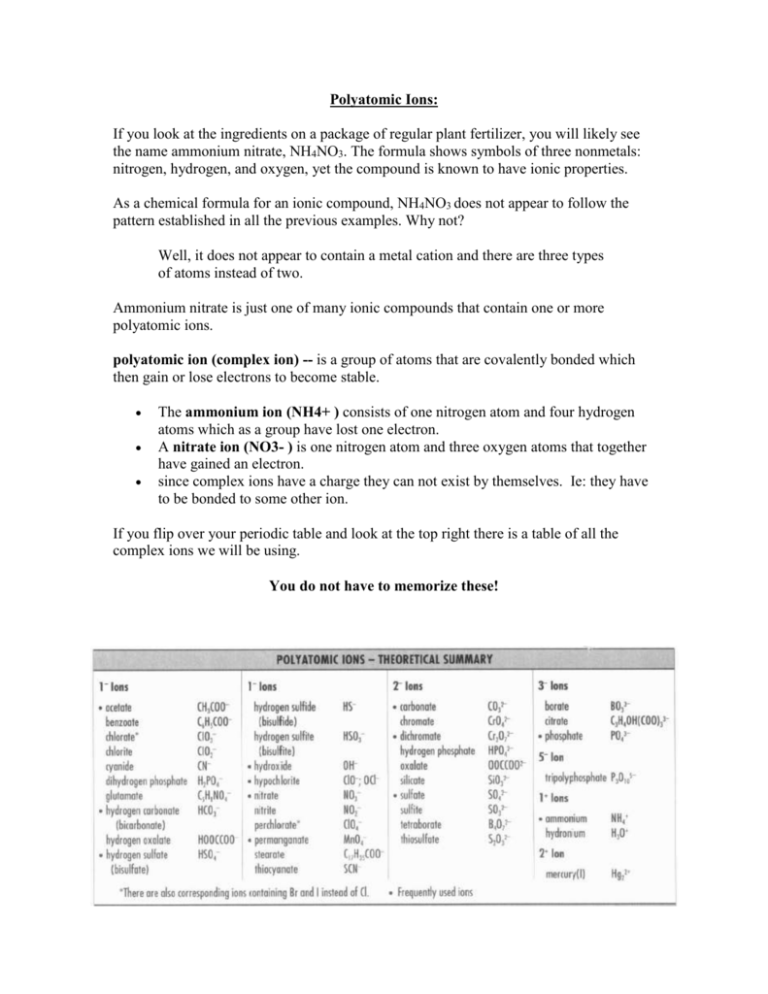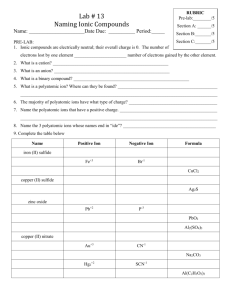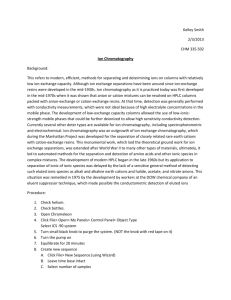Polyatomic Ions:
advertisement

Polyatomic Ions: If you look at the ingredients on a package of regular plant fertilizer, you will likely see the name ammonium nitrate, NH4NO3. The formula shows symbols of three nonmetals: nitrogen, hydrogen, and oxygen, yet the compound is known to have ionic properties. As a chemical formula for an ionic compound, NH4NO3 does not appear to follow the pattern established in all the previous examples. Why not? Well, it does not appear to contain a metal cation and there are three types of atoms instead of two. Ammonium nitrate is just one of many ionic compounds that contain one or more polyatomic ions. polyatomic ion (complex ion) -- is a group of atoms that are covalently bonded which then gain or lose electrons to become stable. The ammonium ion (NH4+ ) consists of one nitrogen atom and four hydrogen atoms which as a group have lost one electron. A nitrate ion (NO3- ) is one nitrogen atom and three oxygen atoms that together have gained an electron. since complex ions have a charge they can not exist by themselves. Ie: they have to be bonded to some other ion. If you flip over your periodic table and look at the top right there is a table of all the complex ions we will be using. You do not have to memorize these! Have a look at the data table right now. Do you notice that many of the polyatomic ion names have endings like ate and -ite? When you look at the name of an ionic compound, the ion name endings are good clues to the presence of polyatomic ions. Many of the ingredient labels on products you find around your house have names with these endings: sodium phosphate (cleaners), calcium carbonate (antacid tablets), sodium hypochlorite (household bleach), and sodium glutamate (meat tenderizer). Writing Chemical Formulas for Compounds with Polyatomic Ions: The formula writing procedure follows the same approach used earlier. You have to focus on balancing the ion charges. Remember to: write the cation symbol first and the anion symbol last. balance the charges by providing the appropriate numerical subscript for each ion. The main difference in writing formulas for compounds that contain polyatomic ions is that occasionally, you need to place brackets around a polyatomic ion symbol if its numerical subscript is greater than one. Sample Exercise 1: Write the chemical formula for each compound. sodium chlorite iron(III) sulfate ammonium permanganate Answers: sodium chlorite 1. Sodium is in Group 1 and forms 1+ ions. sodium is Na+ 2. The -ite suffix in chlorite suggests that it may be a polyatomic ion. Find the name chlorite in the table of polyatomic ions and list its formula and charge. chlorite is ClO2- 3. Since the 1+ charge on the sodium ion is balanced by the 1- charge on chlorite, one of each ion is needed in the formula. The chemical formula of sodium chlorite is NaClO2. Iron(III) Sulfate 1. The Roman numeral III indicates that the iron ion has a 3+ charge. iron(III) is Fe3+ 2. Sulfate has the -ate ending so it is probably a polyatomic ion. A quick look at the table of polyatomic ions confirms this. sulfate is SO42- 3. Balance the charges. (Fe3+) x 2 = 6+ (SO42-) x 3 = 6- (6+) + (6-) = net charge 0 o o The sulfate symbol gets the subscript 3: (SO4)3. Note the use of brackets to separate the 4 from the 3. Without them the polyatomic ion formula would show 43 oxygen atoms: SO43! The chemical formula for iron(III) sulfate is Fe2(SO4)3. Ammonium Permanganate: 1. Ammonium is a polyatomic ion. A IUPAC convention is that cation names should end in -ium. The polyatomic ions table lists ammonium as a 1+ ion: NH4+. 2. The -ate suffix in permanganate suggests that it may be a polyatomic ion. Locate the name permanganate in the data table and list its formula and charge: permanganate is MnO4-. 3. Since the 1+ charge on the ammonium ion is balanced by the 1- charge on permanganate, one of each ion is needed in the formula. The chemical formula of ammonium permanganate is NH4MnO4. Note that parentheses are not required because just one of each ion is needed to produce a neutral unit. Write formulas for the following: 1. Sodium Hydroxide 2. potassium bicarbonate 3. potassium carbonate 4. Magnesium hydroxide 5. Ammonium sulfate Writing Names for Compounds Containing Polyatomic Ions Writing names for compounds containing polyatomic ions is as straight forward as the process was for naming binary ionic compounds. 1. Begin by identifying the anion. 2. Then identify the cation. 3. Finally write the compound name as: cation first and anion second. Sample Exercise: Write the IUPAC name for each formula. (NH4)3PO4 Cr(NO3)3 Answers: (NH4)3PO4 1. Locate the PO43- symbol in the polyatomic ion table. PO43- is phosphate. 2. Locate the NH4+ symbol in the polyatomic ion table. NH4+ is ammonium. 3. Write the names in this order, cation first, anion second: ammonium phosphate. Cr(NO3)3 1. Locate the NO3- symbol in the polyatomic ion table. NO3- is nitrate. 2. Locate Cr in the multivalent ion table. Note that it is multivalent (more than one possible charge). Since there are three nitrate ions, each with a 1- charge, the total negative charge in the formula is 3-. This means that the chromium ion must have a 3+ charge. Cr3+ is chromium (III). 3. Combine the names in this order: cation first, anion second: chromium (III) nitrate. Important Note: The reason you locate the anion symbol and name first is to assist in identifying the charge on the cation should it be multivalent as in the case of chromium(III) nitrate above. Your Turn: Give the name for each of the following: 1. Zn(OH)2 2. Pb(NO3)2 3. Mg(CH3COO)2 4. Na3BO3 5. K2Cr2O7 Zinc Hydroxide Lead (II) nitrate Magnesium Acetate Sodium Borate Potassium Dichromate Ionic Hydrates An ionic hydrate is a compound that has water associated with it. Water is part of its crystalline structure. Bluestone (CuSO4 · 5 H2O) contains five water molecules per copper(II) ion and sulfate ion in the crystal. Its molecular formula is CuSO4 · 5 H2O. Its IUPAC name is copper(II) sulfate pentahydrate. The term anhydrous means without water, thus the name for anhydrous compound is simply copper(II) sulfate, and the molecular formula is CuSO4. A hydrate like rock salt, sodium chloride monohydrate (NaCl·1H2O), can be formed when a salt water lake dries up leaving behind solid salt. However, not all of the water evaporates. Some water molecules became part of the salt crystals giving rise to hydrated crystals. Writing Chemical Formulas for Ionic Hydrates: The name of an ionic hydrate can be distinguished from the names of other ionic compounds by the presence of the term hydrate. For example, the IUPAC name for bluestone is copper(II) sulfate pentahydrate. In order to convert IUPAC names for ionic hydrates into chemical formulas, you will need to know the prefix system learned earlier. Here is the list of these prefixes and the numbers associated with them just in case you have forgotten them. mono di tri tetra penta hexa hepta =1 =2 =3 =4 =5 =6 =7 octa nona deca =8 =9 = 10 Sample Exercise 3: Write a chemical formula for each hydrate. sodium thiosulfate pentahydrate copper(II) carbonate hexahydrate Answer sodium thiosulfate pentahydrate 1. Break the name down into three parts: o The -ate ending in thiosulfate suggests that the anion is polyatomic: thiosulfate is S2O32- o Sodium is a member of Group 1 and has a 1+ charge: Na+ o The hydrate is pentahydrate which means five water molecules: pentahydrate is · 5 H2O. 2. Balance the ion charges: o two Na+ ions are needed for each S2O32- ion. 3. Putting all this together, you get: Na2S2O3 · 5 H2O. Notice that a dot separates water from the rest of the formula. cobalt (II) chloride dihydrate 1. Break the name down into three parts: o Chloride is a simple ion of chlorine (group 17) thus it has a 1- charge. Clo Cobalt(II) is a cobalt ion with a 2+ charge. Co2+ o The hydrate is dihydrate which means two water molecules. ·2 H2O. 2. Balance the ion charges: o one Co2+ ion is needed for each Cl- ion. 3. Putting all this information together, you get: CuCl2 · 2 H2O Again, notice that a dot separates water from the rest of the formula. Your Turn: 1. zinc sulphate heptahydrate 2. potassium sulphate decahydrate 3. Cadmium (II) nitrate tetrahydrate Writing Names for Ionic Hydrates: Converting a chemical formula for an ionic hydrate into a name is a reversal of the steps you do to write the formula. Sample Exercise: Write the IUPAC names for these hydrates: Ni3(PO4)2·8H2O Fe(OH)3·3H2O Answers: Ni3(PO4)2·8H2O Break the chemical formula into three parts. Begin with the anion. Locate "PO4" in the polyatomic ions table. PO43- is the phosphate ion. Next identify the cation and its charge. Since each phosphate ion has a 3- charge, the total negative charge in the formula is (2 x 3-) = 6-; therefore, the charge on each of the three nickel ions must be 2+ (6 ÷ 3 = 2). Thus, the nickel ion is nickel(II). Finally, · 8 H2O means eight water molecules per formula. Find the prefix for eight and write the hydrate name: · 8 H2O is octahydrate. Combine the three parts of the name: nickel(II) phosphate octahydrate. Fe(OH)3·3 H2O Break the chemical formula into three parts. Begin with the anion. Locate "OH" in the polyatomic ions table. OH- is the hydroxide ion. Next identify the cation and its charge. Since hydroxide has a 1- charge, and since there are three of them in the formula, the charge on each iron ion must be 3+. Thus, the iron ion is iron(III). Finally, ·3H2O means three water molecules per formula. Find the prefix for three and write the hydrate name: ·3H2O is trihydrate. Combine the three parts of the name: iron(III) hydroxide trihydrate. Again, note that it is a good idea to begin by locating the anion charge and name in case the cation is multivalent. Your Turn: Give the formula for each of the following: 1. AlCl3 · 6 H2O 2. MgSO4 · 7 H2O 3. CuSO4 · 5H2O Summary: Let’s summarize the naming and formula writing rules for all ionic compounds. Writing Chemical Formulas for Ionic Compounds Given a Name: If the given name contains a metal ion name and nonmetal ion name, then it is a binary ionic compound. Use the periodic table to predict the ion charges. Write the balanced formula by ensuring that the total positive charge is balanced by the total negative charge. Be sure the formula is the lowest whole number ratio (e.g. X1Y2 not X2Y4). If the cation name is followed by a Roman numeral, then you know the charge of the cation. Use the periodic table or the table of polyatomic ions to determine the charge of the anion. Write the balanced formula by ensuring that the total positive charge is balanced by the total negative charge. If the name contains one or two polyatomic ion names (ite, ate , hydroxide, ammonium) look up their ion formulas and charges in the polyatomic ions table. Write the balanced formula by ensuring that the total positive charge is balanced by the total negative charge. If the name contains the term hydrate with a prefix, then write the formula name using the appropriate rules and add · X H2O to the formula where X is the number corresponding to the prefix. Writing a Name Given the Chemical Formula: If the formula contains a metal ion and a nonmetal ion, then the compound is binary ionic. The name of the metal ion is written in full followed by the name of the nonmetal ion. Note nonmetal ions have an -ide ending. If the metal ion is a multivalent species, use the charge of the anion to determine the charge of the cation and write the appropriate Roman numeral in brackets after the name of the cation. Complete the name by adding the name of the anion. If the cation or the anion (or both) is not a simple ion, then consult the polyatomic ions table for the name(s). Then follow the other applicable naming rules. If the formula contains a water molecule preceded by a dot and a number (e.g. · 5 H2O), then the compound is an ionic hydrate. Name the compound using the appropriate rules and add the hydrate name with the correct prefix. Naming and formula writing skills must be mastered if you are going to succeed with the remainder of this course. Work diligently by doing all the textbook exercises. The best way to master the rules is to practice, practice, practice.







